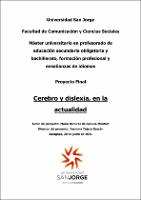Por favor, use este identificador para citar o enlazar este ítem:
https://repositorio.usj.es/handle/123456789/744
Registro completo de metadatos
| Campo DC | Valor | Lengua/Idioma |
|---|---|---|
| dc.contributor.advisor | Tejero Gascón, Yasmina | - |
| dc.contributor.author | Remírez de Ganuza Monfort, María | - |
| dc.date.accessioned | 2021-12-21T10:30:11Z | - |
| dc.date.available | 2021-12-21T10:30:11Z | - |
| dc.date.issued | 2021-06 | - |
| dc.date.submitted | 2021-06 | - |
| dc.identifier.uri | https://repositorio.usj.es/handle/123456789/744 | - |
| dc.description | In this work we seek to focus on dyslexics, a student body, who despite being legally protected, is harmed by this system. Although these students have an intact intellectual capacity, it is difficult for them to continue with their studies. Dyslexia is a commonly used diagnosis, either because the child population that suffers from it is abundant (5%- 17%) or because the term is widely used by groups of psychopedagogy and education, however it is worth noting its lack of conceptual definition, as well as the lack of consensus among the investigating authors of this in their typologies, thus making a clear commitment to an effective intervention method difficult. Increasingly, it is seeking to integrate pre-existing knowledge of the brain into education. From this search a new discipline called neuroeducation has been born. In this critical review we seek to bring together these two concepts, neuroeducation and dyslexia, and see how this new discipline can benefit when dealing with this neurodevelopmental disorder. The main points on which we will focus are, on the one hand, neuronal plasticity, which is the theoretical basis of neuroeducation. On the other hand, neuroimages, with which neuroeducation works. This new way of visualizing the brain can allow us to diagnose dyslexia in advance, improve the literacy learning process, predict the outcome of the intervention, observe the compensatory pathways established by this type of student and jointly understand all the consequences of dyslexia. We will also see some neuroeducational programs, which together could treat almost all thesymptoms of this syndrome. In this work we want to highlight the broad benefits that neuroeducation can bring to the fight against dyslexia. However, dyslexia is a complex syndrome, and so will be the way to approach it. Neuroeducation is not the exclusive answer to all the problems that arise, but it can be a great ally. | es_ES |
| dc.description.abstract | En este trabajo buscamos centrarnos en los disléxicos, un alumnado que, a pesar de estar amparado legalmente, sale perjudicado con el actual sistema educativo, basado fundamentalmente en la lectoescritura. Aunque estos alumnos tienen la capacidad intelectual intacta, les es difícil continuar con sus estudios. La dislexia es un diagnóstico comúnmente usado, bien sea porque la población infantil que lo padece es abundante (5%-17%) o porque el término es muy usado por colectivos de la psicopedagogía y educación, sin embargo, cabe destacar su falta de definición conceptual, así como la falta de consenso entre los autores investigadores de este en sus tipologías, dificultando así una apuesta clara por un método de intervención eficaz. Cada vez más, se busca integrar los conocimientos preexistentes del cerebro en la educación. De esta búsqueda, ha nacido una nueva disciplina denominada neuroeducación. En esta revisión crítica buscamos aunar estos dos conceptos, neuroeducación y dislexia, y ver como esta nueva disciplina puede beneficiar a la hora de tratar con este trastorno del neurodesarrollo. Los principales puntos en los que nos centraremos son por un lado la plasticidad neuronal, que es la base teórica de la neuroeducación, por otro lado, las neuroimágenes, con las que trabaja la neuroeducación. Esta nueva manera de visualizar el cerebro nos puede permitir diagnosticar con antelación la dislexia, mejorar el proceso de aprendizaje lectoescritor, predecir el resultado de la intervención, observar las rutas compensatorias que establece este tipo de alumnado y comprender de manera conjunta todas las consecuencias de la dislexia. También veremos, algunos programas neuroeducativos, que de manera vinculada podrían tratar casi todos los síntomas de ese trastorno. En este trabajo queremos destacar los amplios beneficios que puede aportar la neuroeducación a la lucha contra dislexia. Sin embargo, la dislexia es un trastorno complejo, y por lo tanto también lo será la manera de abordarlo. La neuroeducación no es la respuesta exclusiva a todos los problemas que se plantean, pero si puede ser una gran aliada. | es_ES |
| dc.format.extent | 74 p. | es_ES |
| dc.format.mimetype | application/pdf | es_ES |
| dc.language.iso | spa | es_ES |
| dc.language.iso | eng | es_ES |
| dc.publisher | Universidad San Jorge | es_ES |
| dc.relation.requires | Adobe pdf | es_ES |
| dc.rights | Attribution-NonCommercial-NoDerivatives 4.0 Internacional | * |
| dc.rights.uri | http://creativecommons.org/licenses/by-nc-nd/4.0/ | * |
| dc.subject | Dislexia | es_ES |
| dc.subject | Cerebro | es_ES |
| dc.subject | Lectoescritura | es_ES |
| dc.subject | Rutas de lectura | es_ES |
| dc.subject | Neuroeducación | es_ES |
| dc.subject | Neuroeducador | es_ES |
| dc.subject | Programas neuroeducativos | es_ES |
| dc.subject | Neurociencia cognitiva | es_ES |
| dc.subject | Dyslexia | es_ES |
| dc.subject | Brain | es_ES |
| dc.subject | Literacy | es_ES |
| dc.subject | Reading paths | es_ES |
| dc.subject | Neuroeducation | es_ES |
| dc.subject | Neuroeducate | es_ES |
| dc.subject | Neuroeducational programs | es_ES |
| dc.subject | Cognitive neuroscience | es_ES |
| dc.title | Cerebro y dislexia, en la actualidad | es_ES |
| dc.type | info:eu-repo/semantics/masterThesis | es_ES |
| dc.rights.accessrights | info:eu-repo/semantics/openAccess | es_ES |
| Aparece en las colecciones: | Máster en Profesorado de ESO, Bachillerato, FP y enseñanza de idiomas | |
Ficheros en este ítem:
| Fichero | Descripción | Tamaño | Formato | |
|---|---|---|---|---|
| Cerebro y dislexia, en la actualidad.pdf | 5,08 MB | Adobe PDF |  Visualizar/Abrir |
Este ítem está sujeto a una licencia Creative Commons Licencia Creative Commons

